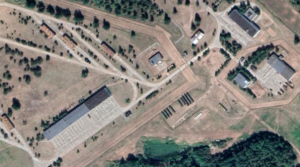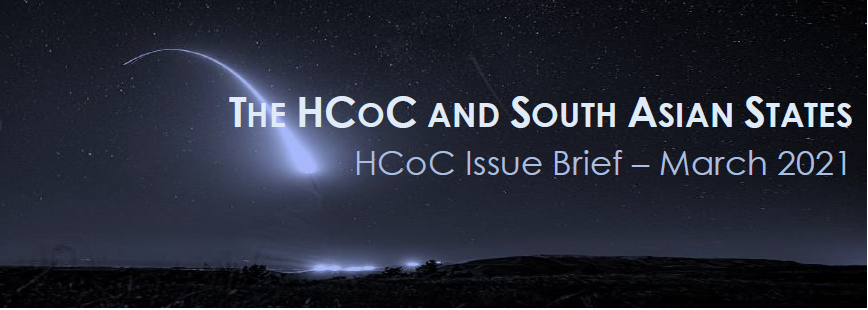
About the Hague Code of Conduct
Adopted in 2002, the Hague Code of Conduct against Ballistic Missile Proliferation (HCoC) is a politically binding instrument aiming to limit the proliferation of weapons of mass destruction (WMD) delivery vehicles. Composed of a set of transparency and confidence-building measures, the HCoC is the only existing multilateral instrument to focus on WMD delivery vehicles. Totalling 93 subscribing states at its inception, the HCoC has now reached 143 subscribing states (April 2020).
When subscribing to the HCoC, states commit to abide by a set of UN treaties and international conventions on space security, to send an annual declaration regarding ballistic missile capacities and national policy on non-proliferation and disarmament treaties and instruments; and to send pre-launch notifications prior to any missile or space launch. Documents are uploaded onto a dedicated online platform managed by Austria, which acts as the HCoC Immediate Central Contact (Executive Secretariat). Subscription to the HCoC is free of charge.
While subscribing states are asked to exercise ‘maximum restraint’ in the development of ballistic capacities, it should be stressed that they are proscribed neither from possessing ballistic missiles nor from pursuing space launch activities. In return, subscribing to the HCoC enables states to gain access to information shared by other subscribing states, and to show their political commitment to non-proliferation and disarmament.
In brief
India’s and Pakistan’s ballistic missiles are mostly designed as delivery vehicles for their nuclear weapons. While intrinsically linked to their national security, ballistic missiles also have regional security implications for South Asia.
Non-proliferation and arms control efforts have so far been aimed at the bilateral level. Subscription to other instruments including the HCoC remains low in the region, although India joined the HCoC in 2016.
Given the high number of missile tests and SLV launches, the HCoC could serve to increase transparency and avoid misunderstandings. It demonstrates responsibility on the part of states sharing information and provides a forum for regional states to voice their concerns. The HCoC also offers a framework for peaceful space development.
Authors: Lauriane Héau and Emmanuelle Maitre
Drivers and impacts of ballistic missile developments in South Asia
Today, the South Asia region i has two active ballistic missile possessors: India and Pakistan.ii The reasons which drove them to acquire ballistic capabilities are multiple, including the desire for status, the search for a capability to inflict considerable damage (especially if coupled with WMD), as well as the psychological effect associated with a potential strike.iii In South Asia, the regional security context has played a major role in ballistic developments. For example, tensions between India and Pakistan largely have contributed to the arms build-up. India has also been concerned with the broader Asia-Pacific region, and notably China – hence its decision to develop intercontinental ballistic missile (ICBM) capabilities. In turn, ballistic developments by both India and Pakistan play a role in the perception and definition by other regional states of their security and strategy. As a result, the risks associated with ballistic missiles are not solely confined to India and Pakistan; rather, these systems also have wider regional implications.iv
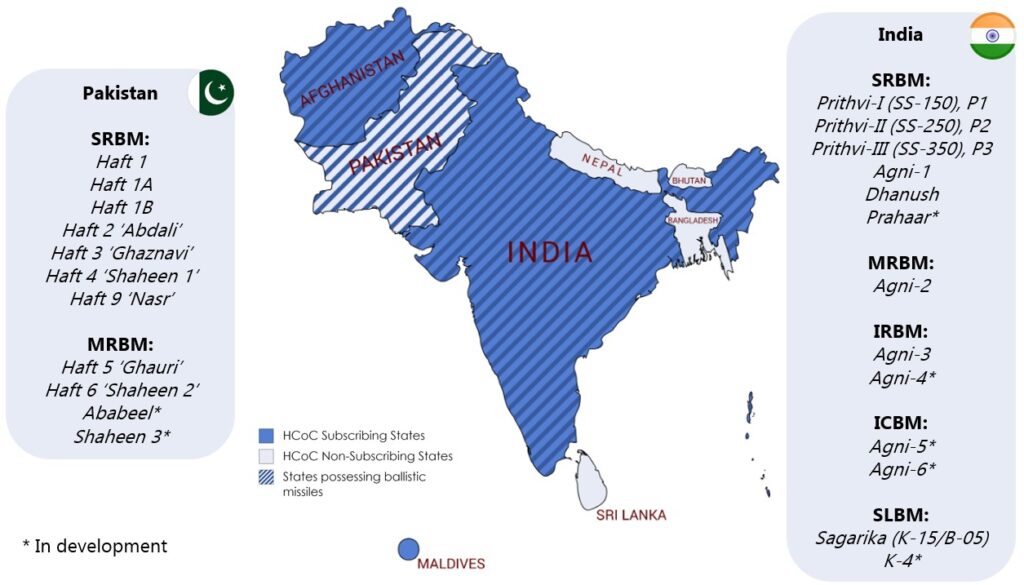
India’s and Pakistan’s ballistic capabilities are, for a large part, linked to their nuclear deterrence strategies. From the 1960s onwards, alongside their acquisition of nuclear weapons (in 1974 for India and in 1998 for Pakistan), both countries began to work on ballistic technologies:
India v In parallel to space research and development, India pursued several missile programmes during the 1970s and the 1980s. It successfully tested the Prithvi short-range ballistic missile (SRBM) in 1988, while at the same time developing the longer-range Agni-1. Today, the country possesses a range of short and medium-range systems, and is developing ICBMs (Agni 5 and 6). It has also embarked on the development of submarine-launched ballistic missiles (SLBMs). India joined the Missile Technology Control Regime (MTCR) and the HCoC in 2016, displaying its commitment to missile non-proliferation.
Pakistan vi Pakistan’s ballistic missile programme derived from its space research programme and began in the early 1960s. This led to the testing of the Haft-1 and Haft-2 ballistic missiles in 1989, and to the subsequent development of several intermediate-range ballistic missiles (IRBMs) with the assistance of both North Korea (Nodong technology) and China (the latter also sold M-11 missiles to Pakistan).vii Today, Pakistan has deployed a range of SRBMs, and the Ghauri and Shaheen MRBMs are identified as the preferred delivery vehicles for the country’s nuclear deterrent.
The recent ballistic developments could further increase the mutual distrust that has long characterised relations between the two regional powers. India is currently developing a ballistic missile defence programme, while Pakistan is investing in Chinese-made Low-to-Medium altitude Air Defence System (LOMADS) LY 80.viii Pakistan may also have acquired Multiple Independently-targetable Reentry Vehicles (MIRV) capabilities,ix while India is developing SLBMs (Sagarika, K-15/ K-4), which might lead to missiles and nuclear warheads being coupled for the first time in the region (the air and land-based components are normally kept in a disassembled state).x Moreover, safety, security and proliferation concerns are fuelled by the activity of non-state actors present in the region. The fielding of very short-range ballistic systems such as the Nasr also poses questions over the ultimate control of nuclear weapons by the political authorities.
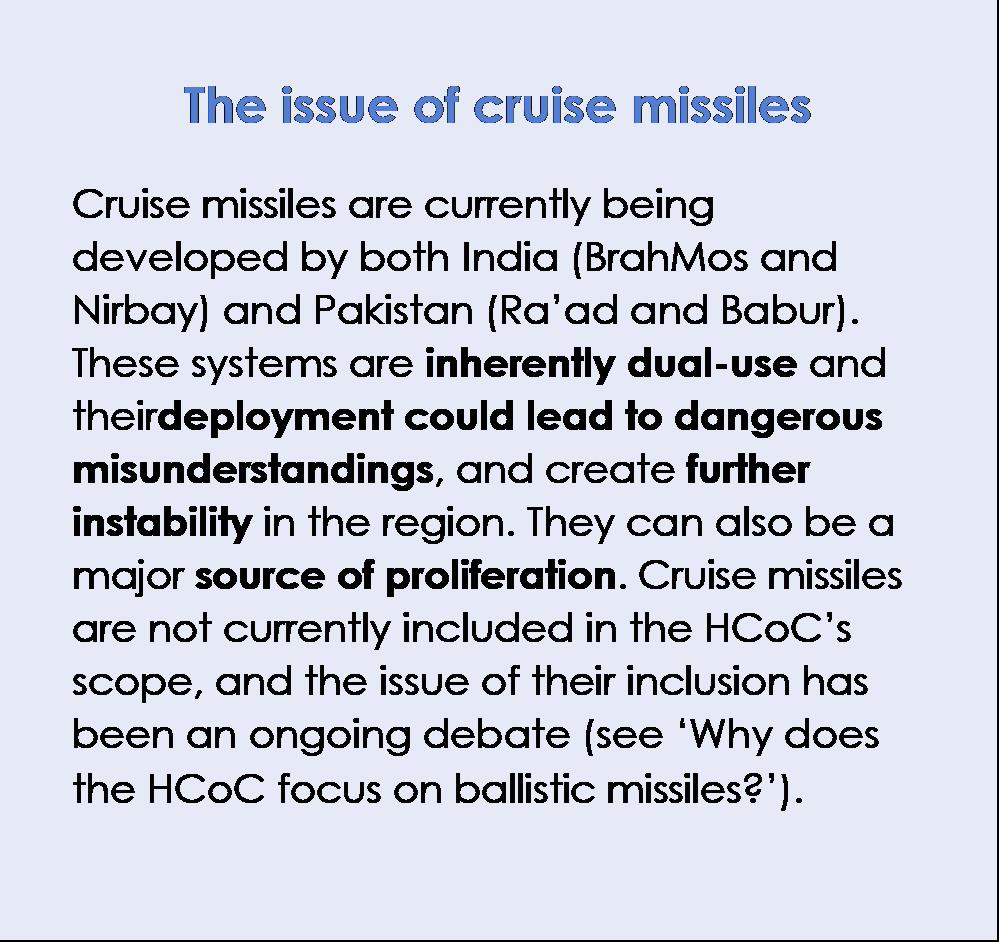
Regional support for WMD disarmament and non-proliferation
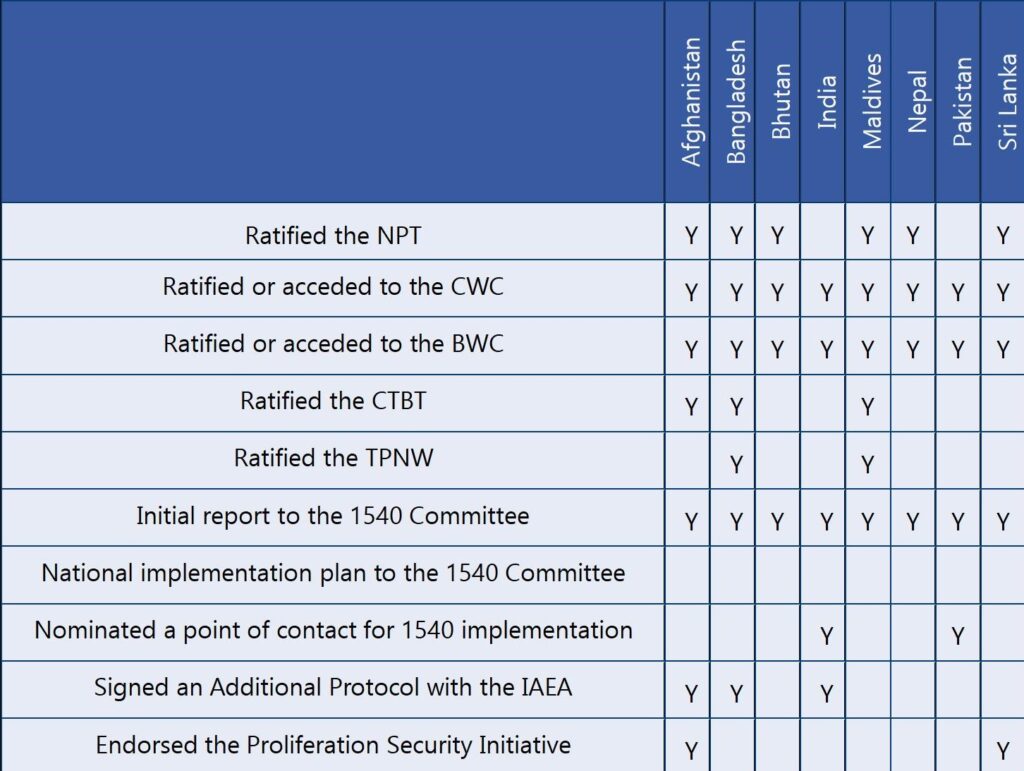
WMD arms control, disarmament and non-proliferation efforts in the region have unsurprisingly been affected by regional tensions and the development of nuclear arsenals by India and Pakistan. In addition, political factors including a disagreement on the principles which underpin the global non-proliferation regime have also led some states to remain outside certain conventions. While South Asian states have overwhelmingly signed or ratified numerous key multilateral instruments (Chemical Weapons Convention (CWC), Biological Weapons Convention (BWC) and Non-proliferation Treaty (NPT)), the two main regional powers, India and Pakistan, remain outside the NPT – the cornerstone of the non-proliferation regime – and are not ready to renounce their nuclear arsenals to join the regime.
Aside from this, the level of subscription to a number of instruments remains low, including on the Comprehensive Nuclear-Test-Ban Treaty (CTBT), which only three South Asian states ratified. Regarding UNSCR 1540, none of the regional states have submitted their National Implementation Plans, nor have the majority nominated a Point of Contact. Similarly, only half of the states in the region have signed an Additional Protocol with the International Atomic Energy Agency.
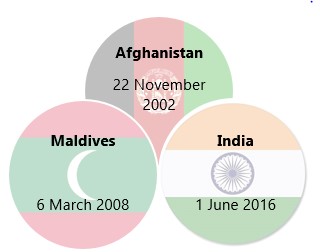
With regards to the HCoC, to date only 3 out of the 8 SAARC member states have subscribed. This means that the region currently has one of the lowest HCoC subscription rates. However, the signature by India in 2016 was a very welcome development, as India is a key actor in the ballistic and space domains.
Moreover, (increasing) votes in favour of the biennial United Nations General Assembly (UNGA) Resolutions endorsing the HCoC illustrate South Asian support for its content and objectives (see Figure 3). Amongst the five regional non-subscribing states, four have almost always voted in favour of the resolutions.
Pakistan remains the only state that systematically abstains in the votes, citing the ad-hoc negotiations of the HCoC – outside the UN framework – and the non-inclusion of cruise missiles as well as ongoing security concerns as reasons for this vote. Moreover, regional states involved in space exploration have joined the various treaties and conventions cited in the HCoC.
India and Pakistan have also negotiated a series of bilateral confidence-building measures (CBMs) – thereby recognising their importance in the field of WMDs and their delivery vehicles. Faced with the high risk of misunderstanding surrounding the development and testing of their respective ballistic capabilities, they adopted the 2005 agreement on advance notification of ballistic missile tests (extended in 2011). The agreement calls for the provision of a 72-hour advance notice of ballistic missile flight tests, and sets clear geographic boundaries and trajectory limitations for such tests.
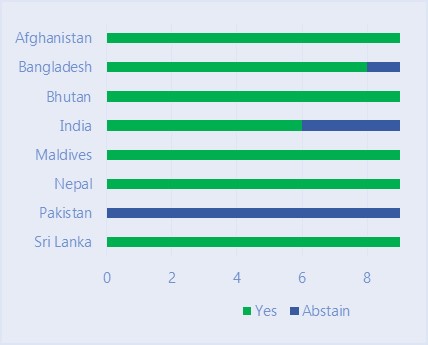
The HCoC as an additional tool for regional stability
Both India and Pakistan aspire to be treated as responsible nuclear powers – this led New Delhi to subscribe to the HCoC. Moreover, the transparency permitted by the annual declarations and pre-launch notifications brings clarity and avoids potential miscalculations. It also demonstrates responsibility on the part of states developing these systems, especially in light of past concerns regarding the transfer of sensitive technologies. The HCoC is also useful for the region more broadly given the high number of missile tests and SLV launches taking place within South Asia. For states that do not have ballistic capabilities, joining the HCoC enables them to voice security concerns and demand accountability from their missile-developing neighbours. As distrust still prevails in the region, CBMs could be an effective way to impose mutual constraints and concretely limit the risk of escalation. Finally, CBMs can lead to efficient and verifiable arms control measures in the long term – a welcome development to curb the regional arms race. Therefore, the HCoC – together with the other existing export control measures, UN regimes and existing bilateral initiatives – constitutes a valuable tool to enhance regional stability and to regulate deadly systems – especially when coupled with WMDs.
The HCoC and space developments
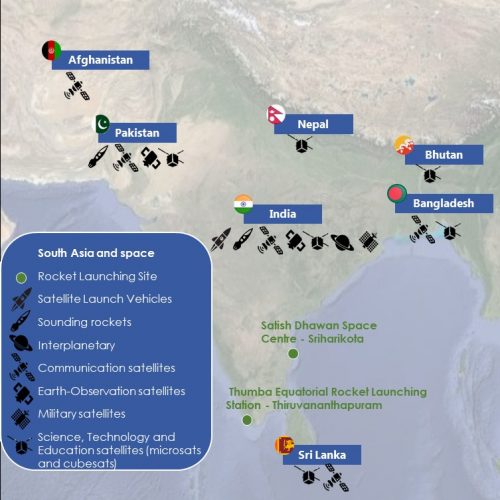
The HCoC also provides space development benefits. In addition to addressing ballistic missiles, the HCoC covers space launches, given that the same technologies can be used for both applications. It recognises ‘that states should not be excluded from utilising the benefits of space for peaceful purposes’ and offers a set of principles and a framework for declaring space launches. This is particularly relevant for South Asia, a region with burgeoning space capabilities. India has become one of the world’s biggest space powers, Pakistan wields significant space capabilities, and all states but one participate in at least one satellite operations. India also launched the South Asia Satellite initiative, which aims to boost telecommunication and broadcasting services, and in which most regional states participate (excluding Pakistan).
Potential applications for satellites are widespread, including advances in telecommunications and education, crop monitoring, infrastructure management, or support in response to natural disasters. But space development can lead to controversial activities and generate insecurity. For instance, the successful anti-satellite (ASAT) test carried out by India in March 2019 xi challenged the notion of peaceful uses of space and triggered international concern because any further such testing could make space a dangerous environment for a number of commercial and civilian endeavours.
In addition, a ’New Space’ trend led by private entities and start-ups is emerging: it uses constellations of small satellites to develop commercial products. This growing demand for launches can become an incentive for more countries and even private companies to develop small launch systems. Such initiatives could create uncertainty as to the destination of the launches, which can be confused with missiles. In such a context, the HCoC has a key role to play in reducing uncertainties and confusion by providing international principles on transparency and confidence-building measures.
i South Asia is here understood within the perimeter of the South Asian Association for Regional Cooperation (SAARC).
ii Afghanistan acquired Scud-B missiles from the Soviet Union in the 1980s. However, the majority of systems is no longer possessed by Afghanistan, and it is likely that the few remaining systems are no longer operational.
iii Emmanuelle Maitre and Lauriane Héau, ‘Current trends in ballistic missile proliferation’, HCoC Issue Brief, September 2020.
iv Natasha Fernando, ‘Ballistic missile proliferation: what should be the role of a small state,’ Institute of National Security Studies Sri Lanka, January 2019.
v ‘India – Missile’, NTI, Last updated: November 2019, https://www.nti.org/learn/countries/india/delivery-systems/.
vi ‘Pakistan – Missile’, NTI, Last updated: November 2019, https://www.nti.org/learn/countries/pakistan/delivery-systems/.
vii ‘Pakistan and North Korea, Dangerous Counter-trades, IISS Strategic Comments, vol. 8, Issue 9, November 2002.
viii Usman Ansari, ‘What does Pakistan need to close its air defense gaps?,’ Defense News, 10 April 2019.
ix Missile Defense Project, ‘Ababeel,’ Missile Threat, CSIS, September 12, 2017, last modified 15 June 2018, https://missilethreat.csis.org/missile/ababeel/.
x Aqeel Akhtar, ‘Nuclear submarines shift strategic balance of Indian Ocean,’ Analysis, IISS, 29 January 2019.
xi Shounak Set, ‘India’s Space Power: Revisiting the Anti-Satellite Test,’ Carnegie India, 6 September 2019.

